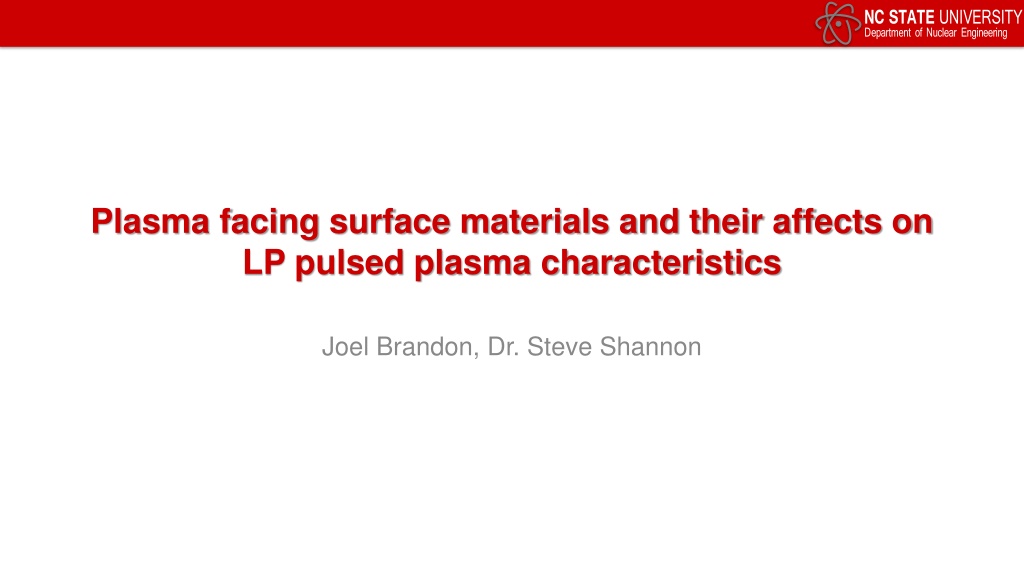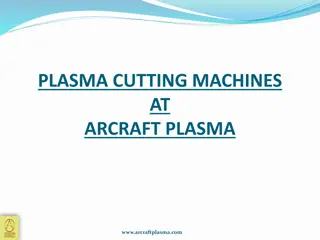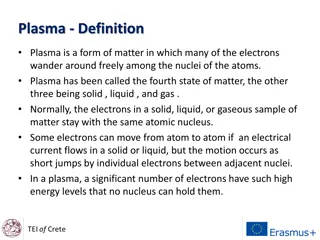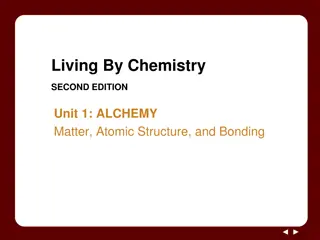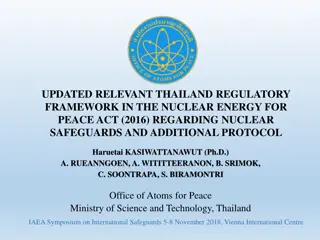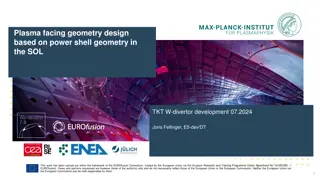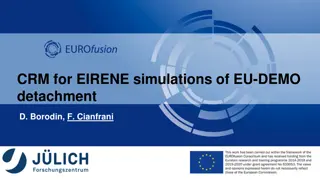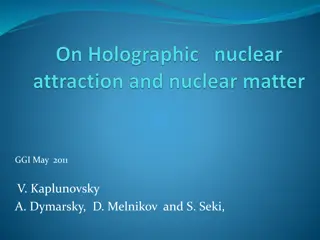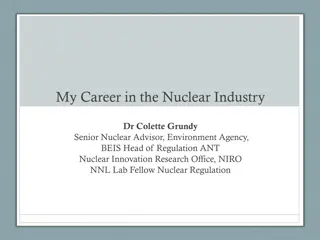Study on Plasma Facing Surface Materials in Nuclear Engineering at NC State University
This research at NC State University's Department of Nuclear Engineering focuses on the effects of plasma facing surface materials on low-pressure pulsed plasma characteristics. The study delves into topics such as electron sources, secondary emission, dissociative recombination, modeling results, changes in oxygen density, experimental work, and future research directions.
Download Presentation

Please find below an Image/Link to download the presentation.
The content on the website is provided AS IS for your information and personal use only. It may not be sold, licensed, or shared on other websites without obtaining consent from the author. Download presentation by click this link. If you encounter any issues during the download, it is possible that the publisher has removed the file from their server.
E N D
Presentation Transcript
NC STATE UNIVERSITY Department of Nuclear Engineering Plasma facing surface materials and their affects on LP pulsed plasma characteristics Joel Brandon, Dr. Steve Shannon
NC STATE UNIVERSITY Department of Nuclear Engineering Summary Summary Background on topic Electron sources Secondary emission ? + ? ????? Dissociative recombination Hypothesis HPEM Modeling results Changes in [O] density Chamber Setup Experimental work Future work Measurables Modifications
NC STATE UNIVERSITY Department of Nuclear Engineering Summary
NC STATE UNIVERSITY Department of Nuclear Engineering Electron Sources Secondary surface electrons Photoelectric Photons Potential Ejection Ions Metastables Kinetic Ejection Fast Ions Fast neutrals Ionizing collisions Electron neutral Charge exchange Penning Ionization Associative detachment Dominant Assumed negligible
NC STATE UNIVERSITY Department of Nuclear Engineering Potential Ejection - Auger Emission Auger De-excitation 2 possible pathways Auger Neutralization Theory of Auger ejection of electrons by metals - Hagstrum 1954
NC STATE UNIVERSITY Department of Nuclear Engineering ? ? ? ???? OES of 844 O line emission in 300 mTorr ?2 plasma ?-like mode separates E and H mode E-H transition supported by secondary electron emission 2) Zaka-ul-Islam
NC STATE UNIVERSITY Department of Nuclear Engineering ? ? ?? ??? LP measurements in CCP show change in EEDF through transition Expect to see this change in ?? and ?2 5) Godyak 1992
NC STATE UNIVERSITY Department of Nuclear Engineering Modeling Efforts ?2 recombination ? + ? + ? ?2 ?? As ?? increases [O] decreases and [?2] increases ??= 0.015 ? + ? ?2+ ? As the O atoms available for dissociative recombination decrease, ? would increase, ? would decrease due to this equation ??= 0.001 3) Shibata et al
NC STATE UNIVERSITY Department of Nuclear Engineering Hypothesis Through material considerations in source design we can create a new knob for transient control and power efficiency of pulsed plasmas by manipulating electron sources.
NC STATE UNIVERSITY Department of Nuclear Engineering ?2 Modeling
NC STATE UNIVERSITY Department of Nuclear Engineering Modeling - ?2 continued HPEM Unrecognizable difference in electron density Noticeable differences in [O] density at electrode
NC STATE UNIVERSITY Department of Nuclear Engineering Chamber Setup
NC STATE UNIVERSITY Department of Nuclear Engineering Chamber setup
NC STATE UNIVERSITY Department of Nuclear Engineering Review of experimental work
NC STATE UNIVERSITY Department of Nuclear Engineering Exp Design Feedthrough on vacuum chamber allows rotation, effectively changing surface material of grounded cathode in active plasma No venting of chamber 6 diameter One whole face covered in copper tape while one side remains aluminum
NC STATE UNIVERSITY Department of Nuclear Engineering Pulsing data for O2 on Cu and Al surfaces SS density has changed Visible difference in rate of rise at the point of E-H transition Upon just flipping from Al to Cu, pressure reading changed by 3- 4mTorr Possibly gas heating, dissociation, or ionization Process was done with constant match settings Readings on surfaces were alternated; Al, Cu, Al, Cu, Al, Cu Data taken with LP 500Hz, 200W, 190 mTorr
NC STATE UNIVERSITY Department of Nuclear Engineering Smith Chart from surface to surface Z=48.699 Z=51.026 4m
NC STATE UNIVERSITY Department of Nuclear Engineering E-H Transition E-H transition Current from VI probe plugged into O-Scope Current decreases faster for aluminum, showing swifter transition from E-H mode Al surfaced plasma has more ? + ? collisions resulting in higher plasma conductivity It was hypothesized that this would exist as a result of changing the secondary electron emission coefficient by changing surface material Still undetermined if this is an effect of recombination or surface electron emission Differences in re-matching vs constant match were minimal and showed same trend Al Cu
NC STATE UNIVERSITY Department of Nuclear Engineering Electrode setup Similar electrode setup to previous experiment Half wafer Surfaces are now thin film deposits Surfaces tested Magnesium Aluminum Copper Silver`
NC STATE UNIVERSITY Department of Nuclear Engineering 50mT pulsed density ~30% increase in ?? for silver surface Opposite what would be expected from recombination effects
NC STATE UNIVERSITY Department of Nuclear Engineering 50mT EEDFs Evolution of EEDF from transient to SS High energy electrons lose their role with the silver cathode 1 2?2?? ??2 High energy electrons play role in transient 1 2 ??=2?? 2? ?? ?? ?????? ?2??
NC STATE UNIVERSITY Department of Nuclear Engineering 100mT
NC STATE UNIVERSITY Department of Nuclear Engineering 100mT EEDFs Still a similar evolution from 50mTorr but less difference between the 2 approaching SS
NC STATE UNIVERSITY Department of Nuclear Engineering 250 mTorr data Less distinct temporal evolution as suggested by 50 100 mTorr case Longer term pulse to pulse change for Ag
NC STATE UNIVERSITY Department of Nuclear Engineering Early runs with silver thin film 50mTorr Al outlier was last run 100mTorr Al outlier was 3rd of 5 runs Subsequent runs for material ~2 min apart
NC STATE UNIVERSITY Department of Nuclear Engineering Mesh netting to eliminate edge light-up Degradation of silver coating after O2 plasma exposure Degradation of copper film after O2 plasma exposure
NC STATE UNIVERSITY Department of Nuclear Engineering Future modifications to experiment
NC STATE UNIVERSITY Department of Nuclear Engineering Optical parametric oscillator for O atom measurements ? ??? ????? ???????? ???????? ?????= ?1+ ?2 ???,??? ???????? ???????? ???? ???????? ?? ????? ????????? ? 205.5 2750 ?? ?? ??? ?1 ?2 ????????? ??????? ????? (attachment for OPO) ??????? ?????????? ?????????? ?????? ?? ??????? Laser output 410-2500nm (18.5k) or 192-2750nm (62.7k) ??? ???????? ??:???
NC STATE UNIVERSITY Department of Nuclear Engineering Future modifications Expandable bellows for Langmuir probe insertion Shrink chamber size OES measurements for OH contamination Re-oxidize surfaces when Al EEDF changes form Compare machined Al surface with Al tape surface Surface roughness
NC STATE UNIVERSITY Department of Nuclear Engineering Review Machined surface vs copper tape showed consistent changes in pulse profile as well as pressure change between the two surfaces Differences in EEDF between surfaces stronger at low pressures Visible difference in pulse density profile for recombination experiments No visible difference in pulse profile for surface electron experiments Silver degradation visible through first set of runs
NC STATE UNIVERSITY Department of Nuclear Engineering References 1. Cold-cathode discharges and breakdown in argon: surface and gas phase production of secondary electrons Phelps and Petrovic 1999 Energetic electron avalanches and mode transitions in planar inductively coupled radio-frequency driven plasmas operated in oxygen Zaka-ul-Islam 2011 Effect of Surface Material on Spatiotemporal Structure in ?2RF Glow Discharge Shibata et al 1995 ?2adsorption on Silicon and Germanium Hagstrum 1961 Evolution of the Electron-Energy-Distribution Function during rf Discharge Transition to the high voltage mode Godyak 1992 Vacuum Thermionic Work Functions of Polycrystaliline Be, Ti, Cr, Fe, Ni, Cu, Pt, and 304 SS Wilson 1966 Material dependent modeling of secondary electron emission coefficients and its effects on PIC-MCC simulation results of capacitive RF plasmas Daksha et al. 2019 Recombination of neutral oxygen atoms on stainless steel surface Mozetic and Zalar 2000 2. 3. 4. 5. 6. 7. 8.
